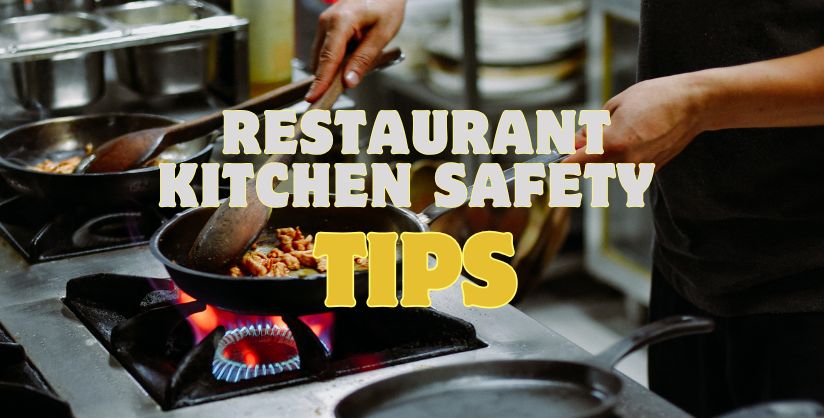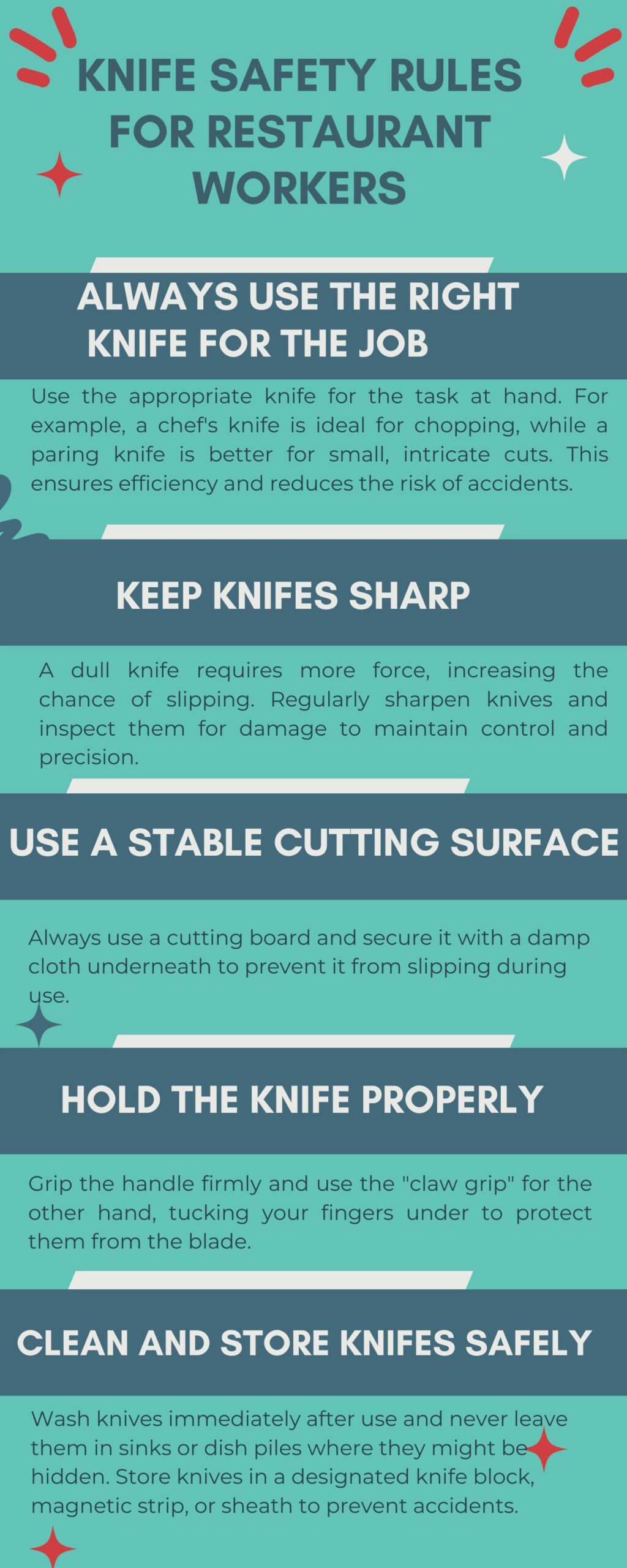

Kitchen safety involves using practices, applying equipment, and following procedures that reduce the risks of accidents, injuries, and food poisoning. Restaurant Kitchen Safety Tips includes appropriate knife handling, fire avoidance, and the maintenance of a clean workspace. These safeguards are particularly crucial in commercial kitchens, where activity levels are elevated and risks proliferate. A safe kitchen promotes well-being and boosts productivity by mitigating physical risks and assuring respect to sanitary regulations.
Table of Contents
Strategies for Restaurant Kitchen Safety Tips
A clean and organised kitchen is vital for safety. Spills, disarray, and incorrect utilisation of equipment are significant contributors to accidents. Consistent sanitation reduces dangers, limits infections growth, and fosters a favourable atmosphere for cooking activities. Optimal lighting and ventilation are essential, as they enhance visibility and diminish airborne grease or smells. Properly storing blades, tools, and chemicals beyond children’s reach mitigates the risk of unintentional injuries or poisonings. Regular equipment checks guarantee appliances run safely and reduce unexpected breakdowns.
Fire safety is an essential consideration. Cooking apparatus is the primary cause of kitchen conflagrations, frequently due to unsupervised culinary activities or the accumulation of grease. To avoid these dangers, it is imperative to maintain a distance between combustible materials, such as towels, and heat sources. Proximity to fire extinguishers and knowledge in managing grease fires, such as suffocating them with a metal lid, can avert minor events from escalating into catastrophes.
Food handling requires attention to both hygiene and safety. The cross contamination between raw and cooked foods can lead to serious problems. Washing hands before eating, using distinct equipment for various ingredients, and refrigerating perishable products at appropriate temperatures contribute to the preservation of safety and food quality.
10 Restaurant Kitchen Safety Tips for a Hazard-Free Space
1. Keep the Kitchen Organized and Clean
An organised kitchen is fundamental to safety. Consistently store goods that are not in use, particularly sharp instruments or large equipment. Promptly address spills to avert slipping dangers and clean surfaces to kill bacteria. Consistent cleaning reduces dangers and guarantees a sanitary atmosphere for culinary activities.
2. Dress for Safety in the Kitchen
wearing proper clothing helps decrease the risk of accidents. Closed-toe, non-slip footwear safeguards your feet against falling objects and slippery floors. Avoid long sleeves and loose garments, as they may capture on pot handles or open flames. For extra protection, wear an apron and secure your hair to prevent contamination.
3. Handle Knifes and Sharp Tools with Care
Knifes are necessary in any kitchen; nonetheless, they can pose a risk if not utilised correctly. Always utilise a solid cutting board and ensure the knife is sharp; poor blades need greater energy and are susceptible to slipping. When traversing with a knife, grasp it by the handle with the blade orientated downward. Store knives securely in a block or on a magnetic clear to prevent accidental cuts.
4. Be Cautious Around Heat and Flames
Burns are one of the most common accidents in the kitchen. Consistently utilise oven glove when managing heated pots, pans, or trays. Position pot handles inward on the hob to avert inadvertent collisions, particularly in the presence of children. Always supervise cooking food and be aware of how to safely extinguish grease fires with a metal lid or baking soda—never use water.
5. Practice Safe Food Handling
Poor food handling may result in cross-contamination and foodborne diseases. Consistently cleanse your hands meticulously before to and subsequent to food handling, particularly when dealing with raw meat or seafood. Utilise distinct cutting boards for raw and cooked foods to avert cross contamination. Additionally, ensure that perishable foods are maintained at the right temperature and used before their expiration date.
6. Use Kitchen Appliances Responsibly
If there are no proper use of equipment may result in injury or damage. Consistently follow to the manufacturer’s guidelines for operation and maintenance. For blenders or food processors, ensure the blades have stopped rotation before lifting the cover. Maintain a safe distance between cords and water, and ensure that appliances are powered off and disconnected when not in operation.
7. Maintain Proper Lighting and Ventilation
Optimal lighting and ventilation improve safety and comfort in the kitchen. Light environments enable clear visibility when utilising sharp instruments or interpreting appliance configurations. Effective ventilation, such an exhaust fan or range hood, diminishes grease accumulation and inhibits the persistence of smoke or odours, so fostering a safer cooking environment.
8. Store Hazardous Materials Securely
Store cleaning agents and combustible substances, like cooking oils, away from heat sources and out of children’s reach. Explicitly designate dangerous materials and store them in a distinct, preferably locked, cabinet. By obtaining these materials, you can avert accidental ingestion, spillage, or conflagration.
9. Prepare for Emergencies with a First Aid Kit
Because of your care, accidents may occur. Maintain a complete first aid kit in the kitchen, containing bandages, antiseptic wipes, and burn ointments. make familiar yourself and others in your family with fundamental first aid protocols for prevalent kitchen injuries, including lacerations and burns.
10. Stay Focused While Cooking
Distractions are a primary contributor to kitchen accidents. Distractions such as a ringing phone or multitasking can lead to fires, accidents, or injuries in the kitchen. Stay present when cooking, and take breaks if you’re feeling tired or overwhelmed. By maintaining your focus, you may assure a safer and more enjoyable cooking experience.
An safe kitchen is a productive and enjoyable environment. Following to these ten recommendations can mitigate hazards, avert accidents, and provide a sanitary atmosphere for meal preparation. Safety in the kitchen pertains not only to individual protection but also to establishing a secure environment for all individuals there. By meticulously attending to details and adhering to regular safety protocols, one can render cooking a safer and more gratifying endeavour.
FAQ - Essential Restaurant Kitchen Safety Tips for a Risk-Free Workplace
Clean spills immediately, use non-slip mats, and wear non-slip shoes to reduce the risk of falling on wet or greasy floors.
Use a knife block, magnetic strip, or a designated drawer with blade covers to secure knives and prevent accidental cuts.
Turn off the heat and smother the fire with a metal lid or baking soda. Avoid using water, which can spread the flames.
Adequate lighting improves visibility, reduces the risk of accidents, and allows you to cook more safely and efficiently.
Include items like bandages, antiseptic wipes, burn ointments, and a pair of gloves to handle minor injuries effectively.
Recent Posts






Course Categories
- Free Courses
- Business Management
- Teaching & Special Education
- QLS Endorsed Course
- Massage & Physiotherapy
- General Education
- Prince2
- Regulated Qualification
- Artificial Intelligence – AI
- Animated Course
- Food Hygiene
- Travel and Tourism
- Legal
- Customer Service
- Interactive Courses
- Training
- Photography
- Mental Health & Counselling
- Career Bundle
- Health & Safety
- Project Management
- Animal Care
- B2B Training
- HR & Leadership
- G Deal
- Makeup & Beauty
- Web Design & Development
- Languages
- Groupon AU
- Nursing & Care
- Premium
- Design
- Teaching & Education
- Sports, Nutrition & Fitness
- Employability
- IT & Software
- Personal Development
- New Courses
- Discount Courses







